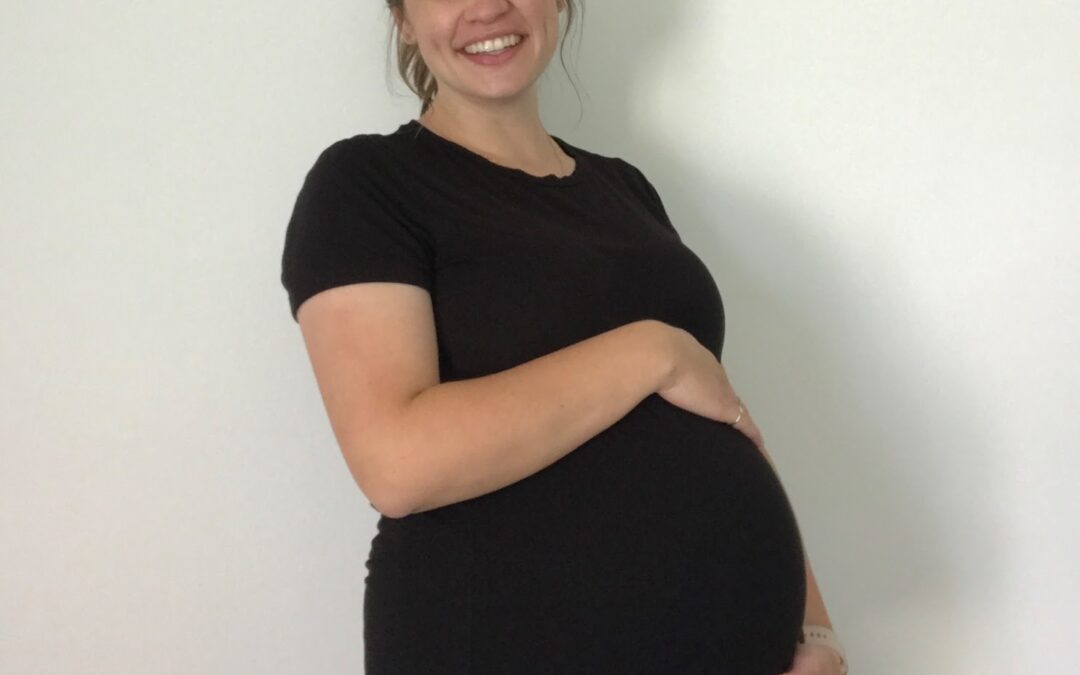At 36 weeks pregnant with my 3rd baby, I can definitely relate to all my pregnant patients with how physically challenging pregnancy can be. As a pelvic floor and pelvic health Physical Therapist, I also know a lot of common issues can be avoided or helped with Physical Therapy.
Here are a few things that have helped me during my pregnancy:
1. Getting in and out of bed
As your belly gets bigger, it gets harder to move in general, specifically to lie down or sit up without plopping or grunting. Straining or holding your breath as you crunch up or down can also make DRA, prolapse, or incontinence issues worse.
Avoid that extra strain! When you lie down, use your arm to lower you onto your side. When you’re ready to get up, roll to your side, let your legs off the side of the bed, and then use your arm to push yourself up. Make sure to use a gentle pelvic floor contraction to help stabilize you. Not sure how to do that? Call us, or your local pelvic PT, and we can show you!
2. Stretch
This is my absolute favorite pregnancy stretch! It stretches my hips, calms down my restless legs, relieves the pressure of my belly when I can’t lie on my stomach, and relaxes my pelvic floor.
To do this stretch, get on your knees and elbows, with knees just wider than shoulder-width apart. Let your belly completely relax and hang toward the floor. Sit back slightly into your hips and think about letting hip bones spread. Diaphragmatic breathing (breathing into your belly and pelvic floor) in this position further facilitates good abdominal and pelvic floor relaxation. I normally stay in this position for a couple of minutes, or until I feel a good stretch. Reminder: this should feel good, pain is not normal.
3. Waddling and Pelvic Pain
Background anatomy and body changes:
Throughout your pregnancy, in addition to the increased progesterone, your body is releasing a hormone called relaxin. Both of these soften the ligaments and cartilage in the pelvis to prepare for delivery. While this process is very important to allow the baby to exit the pelvis, it can lead to some common issues during pregnancy.
This laxity, in addition to the increasing weight of the uterus, can lead to discomfort through the sacroiliac joints, low back, and the symphysis pubis. When you feel unstable, or in pain, the muscles guard around the extra movement, leading to muscle soreness and even nerve irritation.
The good news is that Physical Therapy can treat this pain! We can evaluate and treat the muscles and joints in and around your pelvis to make sure your body is moving correctly to not cause pain. It is important to look at the way your body moves all through the day, and how you are managing those movements. Finding a Physical Therapist who specializes in pelvic health is important in understanding the whole body during pregnancy, and the changes that are being made. Your body is much different while pregnant, and your therapist should have special training to fully understand this.
Waddling is a common side effect of changing body mechanics. You have probably heard that waddling is inevitable during pregnancy, especially during your third trimester. I know firsthand how it feels when your body is tired and sore, and waddling seems like the only way to make it across the hall to the bathroom in the middle of the night.
I am here to tell you that this is another one of those things that is COMMON, but NOT NORMAL. Wadding is actually a malcompensation, meaning it’s an adaptation that your body makes, but it’s not good for you! It can cause extra strain on your sacroiliac joints, symphysis pubis, hips, spine as well as other joints and muscles in your body.
Waddling is completely avoidable by just two small muscle engagements. First, slightly engage your pelvic floor. This will automatically activate the transversus abdominis, your deep core abdominal muscle. This should be a subtle contraction, about 25% or less of a maximal contraction. This will give more stability to your pelvis. The other muscle to think about engaging is the top of your glutes (buttock muscles). As you push off of the leg that’s behind you, gently squeeze that bumcheek. That will help advance your weight forward instead of rocking side to side. Basically, your legs should be under and behind you, instead of reaching in front of you.



